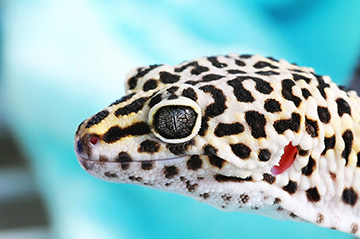
Gecko ears contain a mechanism similar to the researchers’ system for detecting the angle of incoming light. [Image: Vitaliy Halenov]
What do the ears of geckos and the photodetecting pixels in your camera have in common? Both gain a big advantage when they can measure the direction of the source—and both are fundamentally limited by size. But while evolution has solved the problem for geckos with sound, it’s been tougher to come up with a nanoscale photodetector that can sense the angle of incoming light.
Now, inspired by geckos’ directional hearing, a U.S. engineering team has designed a subwavelength photodetector capable of measuring both the intensity and incident angle of light (Nat. Nanotech., doi: 10.1038/s41565-018-0278-9). These tiny detectors could eventually support advances in lensless cameras, augmented reality and robotic vision.
Trending smaller
According to the Stanford University and University of Wisconsin, USA, research team, this system is the first of its size to determine the angle of light, and in a much simpler way than existing depth-sensing methods.
Pixels in a conventional imaging chip can detect only light intensity, and would typically need to be combined with bulky lenses to glean this information. But as imaging systems continue to scale down, pixel size is rapidly approaching the optical wavelength, and conventional optical elements like lenses cannot be miniaturized indefinitely without sacrificing accuracy. Angle-sensitive subwavelength pixels are thus, the team believes, a very attractive prospect for advanced imaging applications.
“Making a little pixel on your photo camera that says light is coming from this or that direction is hard because, ideally, the pixels are very small—these days about 1/100th of a hair,” OSA Fellow Mark Brongersma at Stanford, a senior author of the study (along with OSA Fellow Shanhui Fan), said in a press release accompanying the study. “So it’s like having two eyes very close together and trying to cross them to see where the light is coming from.”
Taking a cue from nature
Animals like humans, with an ear-to-ear spacing that exceeds audible sound wavelengths, can triangulate the source of a sound via the intensity and time differences of sound waves in their individual ears. Geckos, and about 15,000 other small animals, have heads that are so small, with ears placed so closely together, that they rely on a tiny tunnel through their heads to triangulate sound. Essentially, soundwaves enter one eardrum and bounce around this tunnel; angle sensing is accomplished through coherent coupling of soundwaves between the two ears.
The team realized that the same phenomenon that allows a gecko to triangulate sound could also triangulate light. The researchers applied an analogous structure to their photodetector by lining up two silicon 100-nm nanowires side by side, mimicking a gecko’s eardrums. Gold electrodes cover the ends of each nanowire, forming two photodetectors, electrically isolated from each other but optically coupled.
The tiny nanowires, which are about 1/1000th as thick as a hair, are positioned so closely that as a light wave comes in at an angle, the wire closest to the light source essentially casts a shadow on its neighbor, interfering with the way the other wire detects the light. Thus, the first wire to detect the light sends the strongest current, and the team is able to map the angle of the light wave by comparing the current in both wires. (More specifically, the two nanowires, when placed closely enough together, behave as coupled Mie resonators, with the ratio of the amplitudes of the two resonators strongly dependent on the angle of the incident light.)
Toward auto, AI and robotic applications
In a demonstration, the team used two angle-sensing photodetectors to triangulate the position of a 520-nm-wavelength LED light source. The researchers mounted the two photodetectors on two chips 50 mm apart. Then, they measured the incident angles of the light and used trigonometry to accurately estimate the LED’s location as it moved.
Since the nanowire setup mimics the geometry of the coupled gecko ears, the system inherits the same limitations, including a limited operational bandwidth, lack of full azimuth and elevation angle capability and difficulty in differentiating multiple incoming waves. The team offers solutions to these problems, such as using multiple resonant detectors to expand the operational bandwidth and to differentiate between waves.
The team believes that its research could lead to angle-sensing pixels for imaging chips that enable a host of light-sensing applications—such as better scene awareness in autonomous vehicles and robotics. The light sensors could also feasibly be incorporated into next-generation smart optoelectronic and artificial intelligence systems. “We’ve worked on this for a long time,” says Brongersma. “It’s fun to think that we might be here for another 20 years figuring out all the potential of this system.”
